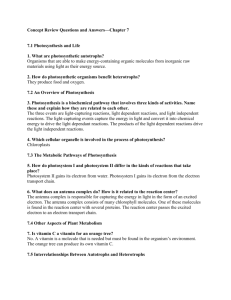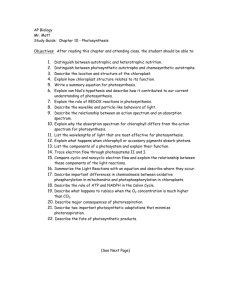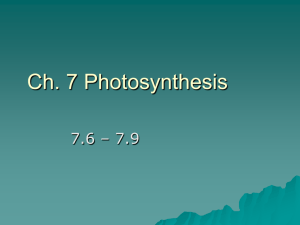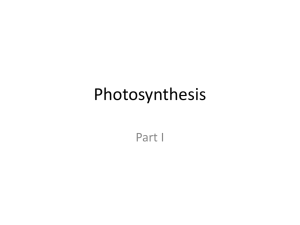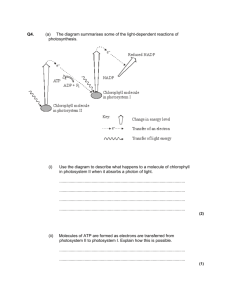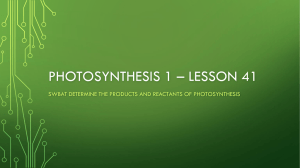By its most common definition, photosynthesis is a process that... carbon dioxide while producing oxygen as a byproduct. With the... Photosynthesis (Light Reactions)
advertisement
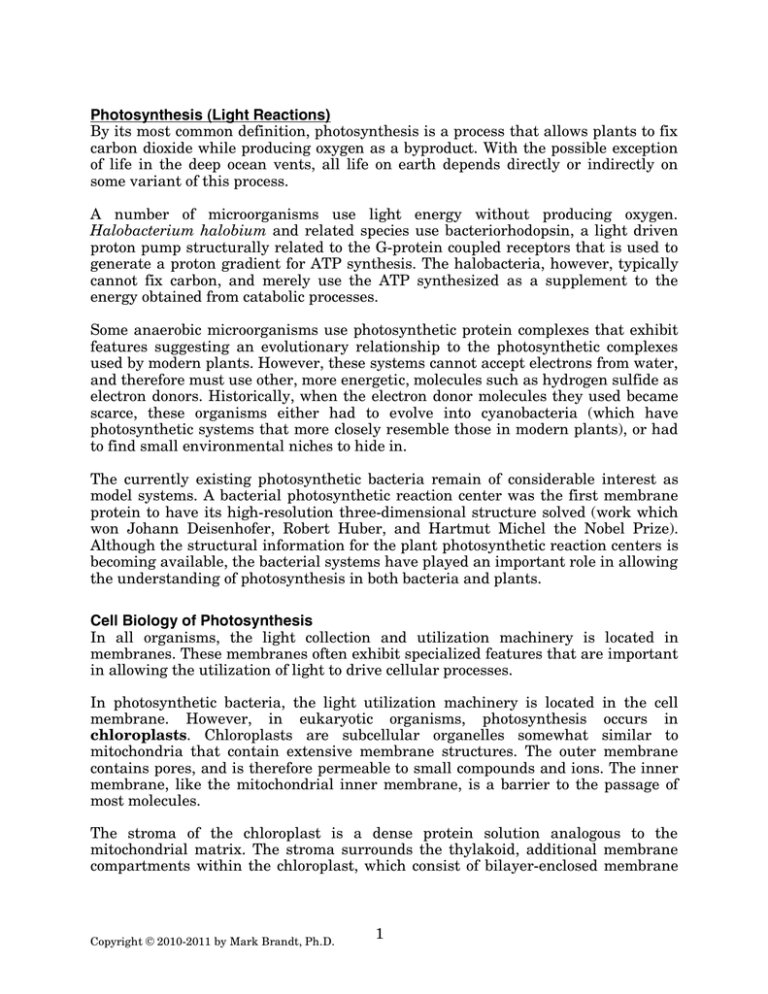
Photosynthesis (Light Reactions) By its most common definition, photosynthesis is a process that allows plants to fix carbon dioxide while producing oxygen as a byproduct. With the possible exception of life in the deep ocean vents, all life on earth depends directly or indirectly on some variant of this process. A number of microorganisms use light energy without producing oxygen. Halobacterium halobium and related species use bacteriorhodopsin, a light driven proton pump structurally related to the G-protein coupled receptors that is used to generate a proton gradient for ATP synthesis. The halobacteria, however, typically cannot fix carbon, and merely use the ATP synthesized as a supplement to the energy obtained from catabolic processes. Some anaerobic microorganisms use photosynthetic protein complexes that exhibit features suggesting an evolutionary relationship to the photosynthetic complexes used by modern plants. However, these systems cannot accept electrons from water, and therefore must use other, more energetic, molecules such as hydrogen sulfide as electron donors. Historically, when the electron donor molecules they used became scarce, these organisms either had to evolve into cyanobacteria (which have photosynthetic systems that more closely resemble those in modern plants), or had to find small environmental niches to hide in. The currently existing photosynthetic bacteria remain of considerable interest as model systems. A bacterial photosynthetic reaction center was the first membrane protein to have its high-resolution three-dimensional structure solved (work which won Johann Deisenhofer, Robert Huber, and Hartmut Michel the Nobel Prize). Although the structural information for the plant photosynthetic reaction centers is becoming available, the bacterial systems have played an important role in allowing the understanding of photosynthesis in both bacteria and plants. Cell Biology of Photosynthesis In all organisms, the light collection and utilization machinery is located in membranes. These membranes often exhibit specialized features that are important in allowing the utilization of light to drive cellular processes. In photosynthetic bacteria, the light utilization machinery is located in the cell membrane. However, in eukaryotic organisms, photosynthesis occurs in chloroplasts. Chloroplasts are subcellular organelles somewhat similar to mitochondria that contain extensive membrane structures. The outer membrane contains pores, and is therefore permeable to small compounds and ions. The inner membrane, like the mitochondrial inner membrane, is a barrier to the passage of most molecules. The stroma of the chloroplast is a dense protein solution analogous to the mitochondrial matrix. The stroma surrounds the thylakoid, additional membrane compartments within the chloroplast, which consist of bilayer-enclosed membrane Copyright © 2010-2011 by Mark Brandt, Ph.D. 1 structures with an interior lumen. The proteins of the light utilization machinery exist within the thylakoid membrane. ./0$#$10&2" !"#$%& '(()#*%)%+#&() ,-")#*%)%+#&() The membrane composition of the thylakoid is unusual; it is composed primarily of carbohydrate-containing derivatives of diacylglycerol, with very few phospholipids. In addition, the lipids contain largely unsaturated fatty acyl chains and are therefore fluid under most conditions. Spectroscopic considerations Although massless, light contains energy. The amount of energy in a mole of photons is dependent on four parameters: Planck’s constant, Avogadro’s number, the speed of light in a vacuum1, and the wavelength of the light. The energy in light is given by the equation below. Based on this equation, blue (400 nm) light = 300 kJ/mol, while red (700 nm) light = 170 kJ/mol. $ $ '' m '$ 23 photons & 6.626x10#34 J • sec & 2.9979x108 )&6.022x10 )) sec (% mol ( ) hc & % E = h! = = ) " & 400x10-9 m & ) % ( ( ) In order to interact with molecules, light must be absorbed. The process involves a change in the energy state of the absorbing molecule, and results in a charge separation within the molecule. When a molecule absorbs a photon, it absorbs energy equal to the energy of the photon, and becomes excited. If the absorbed photon has sufficient energy, the molecule may become excited to the higher electronic excited states (such as S2 in the diagram below). The molecule then usually releases some energy as it rapidly (about 10–12 to 10–11 seconds) drops to a lower energy level within the excited state 1 NIST has recently released updated values for some of these constants. For anyone really interested in precision, the currently accepted values of these constants are: Planck’s constant: 6.62606896 x 10–34 ± 0.00000033 x 10–34 Joules•sec, Speed of light: 299792458 ± 0 m/sec Avogadro’s number: 6.02214179 x 1023 ± 0.00000030 x 1023 objects/mol Other fundamental constants can be obtained from the NIST website <http://physics.nist.gov/cuu/Constants/index.html>. Copyright © 2010-2011 by Mark Brandt, Ph.D. 2 (and if necessary to the lowest excited electronic state, S1). The S1 electronic state is somewhat stable, and, for many molecules, has a significant lifetime (usually about 10–9 to 10–8 seconds). Molecules involved in photosynthesis usually have lifetimes of at least 10–8 seconds. 3()#45 !> !7 :$"&"9$(&0 2"&")2 30);"#$(9; 2"&")2 !6 89+#&"9$(&0*2"&")2 <$0);-0&#*=)$%)"#5 A molecule can return to its ground state, S0, by one of five main mechanisms. Internal conversion is a radiationless process, in which the charge separation is converted to increased vibrational motion within the molecule. For most molecules, the transition from higher electronic states to the S1 electronic state occurs via internal conversion. Dynamic quenching is a radiationless process, in which the excited molecule collides with other molecules and transfers its energy to the other molecule. The other molecule then becomes excited, and may undergo one of these processes as it returns to its ground state. Fluorescence is a re-emission of a photon. In most molecules, the fluorescent emission involves lower energy than the initial absorption event because of vibrational relaxation and other effects, and therefore consists of photons with a longer wavelength than the exciting photon. Fluorescence resonance energy transfer (also referred to as exciton transfer) is a process that allows direct transfer of energy from one molecule to a nearby molecule with similar or slightly lower energy states. Because resonance energy transfer is a quantum mechanical process, the energy transfer is controlled by allowed energy levels; transfer between identical molecules (with identical energy levels) is performed without loss of energy. Resonance energy transfer is a shortrange process, and falls off rapidly with distance. Because the efficiency of transfer Copyright © 2010-2011 by Mark Brandt, Ph.D. 3 decreases as 1/R6, molecules separated by more than ~100 Å will not perform resonance energy transfer. This sets physical limits on the dimensions of the photosynthetic machinery. Photochemistry is a process in which the excitation of the molecule triggers chemical reactions. One type of photochemical process is photooxidation, which is the result of loss of an electron; the absorption process causes a charge separation, and this more mobile charge can reduce other molecules. Limiting undesired photochemistry and promoting desired photochemistry place major constraints on the photosynthetic machinery. Solar Irradiance at Earth Orbital Distance 2 –2 –1 Spectral Irradiance (W•m •nm ) Light collection Sunlight reaching the earth surface has maximum intensity in the visible range. This is true because the solar emission maximum is about 500 nm. It is also true because of atmospheric absorption of the sunlight alters the amount of light of specific wavelengths reaching the surface. Wavelengths shorter (far ultraviolet) and longer (infrared) than visible light are largely absorbed by atmospheric gasses; the entire spectrum is attenuated by both absorption and scattering. (Note that the ozone layer is largely responsible for absorption of the high energy ultraviolet photons; recently, the intensity of these high energy photons reaching the surface has been increasing due to human-induced decrease in the amount of stratospheric ozone.) In the graph below, the radiation reaching the earth is shown as it would exist if the atmosphere were not present, and as a reasonable average of the radiation observed at the surface measured at 37° of latitude.2 1.5 1 0.5 Solar Irradiance at Earth Surface (37° latitude) 0 300 400 500 600 700 800 900 1000 Wavelength (nm) 2 Data from the reference AM 1.5 spectra published by the American Society for Testing and Materials (see http://rredc.nrel.gov/solar/spectra/am1.5/) Copyright © 2010-2011 by Mark Brandt, Ph.D. 4 3?"9(;"9$(*.$)@@9;9)(" Proteins comprised solely of amino acids do not absorb in the visible range. Because most of the light from the sun is present in visible part of the spectrum, and because other molecules exhibit far more useful properties for the photosynthetic process than unmodified polypeptides, photosynthetic proteins use a variety of cofactors for the light collection and utilization process. The chart below shows the absorbance properties of some of the photosynthetic pigments discussed further below, with the human visual range shown on the same scale. ./0$#$1/500*" ./0$#$1/500*" ./0$#$1/500*! A66 B66 C66 D66 E66 H&I)0)(4"/*J(%K 3?"9(;"9$(*.$)@@9;9)(" L11#$?9%&") #&(4)*$@*/-%&( I929$( G&;")#9$;/0$#$1/500*! F/5;$)#5"/#$+909( A66 B66 C66 D66 E66 H&I)0)(4"/*J(%K The two main types of chlorophyll are the most commonly used photoreceptor molecules. All types of chlorophyll are protoporphyrin IX-derived compounds (the structures of these compounds are shown below). The protoporphyrin IX structure is modified in several different ways from its wide use in heme; most chlorophyll contains Mg2+ instead of an iron ion, has an additional ring, and contains a hydrophobic phytyl side chain. Copyright © 2010-2011 by Mark Brandt, Ph.D. 5 The upper graph shows the absorbance spectrum for the chlorophyll types found in plants and some other organisms. Chlorophyll a and b are plant compounds with (as is apparent in the spectra shown above) somewhat different absorption spectra due to the different modifications present in each molecule. Note the large gap between about 500 and 600 nm; this green portion of the spectrum is not absorbed by most plants, and accounts for the characteristic green color reflected by these organisms. H O N N N Mg2+ N N N N N Fe3+ N H O O O O O N Mg2+ N N H O O O O O O O O O Iron-Protoporphyrin IX Chlorophyll a Chlorophyll b Another chlorophyll variant is pheophytin, which contains two protons in place of the chlorophyll Mg2+. Plants also contain modified terpenes that include carotenoids such as !-carotene and related compounds (see examples shown below). These compounds, like chlorophyll, contain extended conjugated double-bond structures that efficiently absorb visible light. During fall, the light-absorbing pigments are degraded at different rates, and therefore the leaves change color dramatically. The presence of different version of these light-absorbing pigments in differing quantities is also responsible for difference in leaf color for different plant species. Lycopene !-Carotene Xanthophyll HO Copyright © 2010-2011 by Mark Brandt, Ph.D. 6 OH Photosynthetic bacteria use similar molecules called bacteriochlorophyll, which contain additional modifications to the chlorophyll structure. The result of these modifications is absorption at longer and shorter wavelengths than those of chlorophyll (compare the spectra for bacteriochlorphyll and chlorophyll in the graph above). O O N N N Mg2+ N N N Mg2+ N N H O O H O O O O O O O O Bacteriochlorophyll a (some have phytyl instead of geranylgeranyl side chain) Bacteriochlorophyll b Like plants, photosynthetic bacteria use both chlorophyll variants and accessory light pigments. While bacteria use carotenoids, many bacteria also contain two other compounds, phycoerythrobilin and phycocyanobilin. These compounds are synthesized using a modification of the heme breakdown process. Because phycoerythrobilin and phycocyanobilin absorb in the green part of the spectrum where chlorophyll does not, they allow the photosynthetic bacteria to obtain light not used by plants. The phycoerythrobilin and phycocyanobilin molecules are typically covalently attached to proteins, resulting in phycoerythrin and phycocyanin, proteins which are separate from the photosynthetic reaction center and exist loosely associated with the membrane. OH O O OH OH O HN O O O NH OH O HN N N H Phycoerythrobilin O NH N N H Phycocyanobilin Each photosynthetic reaction center complex contains large numbers of chlorophyll molecules. However, the vast majority of the chlorophyll and carotenoid lightabsorbing pigments is present in other proteins. These antenna proteins comprise the light harvesting complexes and act to collect light and funnel it to the reaction center. The light harvesting complexes interact with photons, and donate the energy by resonance energy transfer to the reaction center. This reduces the Copyright © 2010-2011 by Mark Brandt, Ph.D. 7 amount of the reaction center complex that must be produced, as well as broadening the spectrum of usable light. Two views of the crystal structure of the light harvesting complex-II (LHC-II) from garden pea Pisum sativum (pdb ID 2BHW) are shown below. The membrane-bound complex contains 24 chlorophyll a, 18 chlorophyll b, and 4 carotenoid molecules. The light harvesting proteins and the reaction center use their three-dimensional structures to ensure that the photon energy collected is distributed by resonance energy transfer, with less than 10% lost due to internal conversion or fluorescence relaxation processes. Because the light harvesting complexes have identical structures, they can use resonance energy transfer to distribute the light energy without losses. The reaction center acts as the final light energy collection point, because its chlorophyll molecules have slightly lower energy than those of the light harvesting complexes. Transfer of the energy from the light harvesting complexes to the reaction center is therefore thermodynamically favorable. 3()#45 3?;9")M*2"&")2 NO.*./0$#$1/500*4#$-(M*2"&")2 Copyright © 2010-2011 by Mark Brandt, Ph.D. 8 :)&;"9$( ;)(")# ;/0$#$1/500 The Light-Driven Reactions of Photosynthesis In plants, the overall photosynthetic pathway can be viewed as essentially glucose catabolism in reverse. It uses a light-driven electron transport pathway to provide the energy for the synthesis of glucose and other molecules. The overall photosynthesis process has two phases. The first phase (the “light reactions”) uses light energy to produce NADPH and ATP using electrons derived from H2O. The second phase (the carbon assimilation reactions) uses these energy-containing molecules to drive carbohydrate synthesis. The discussion immediately below covers the light reactions; the carbon assimilation reactions are discussed in the next section. Reaction centers The chemical reactions driven directly by light occur at protein complexes called photosynthetic reaction centers. Purple photosynthetic bacteria and green sulfur bacteria contain single photosynthetic reaction centers. This limits the types of chemistry that they are capable of performing. Cyanobacteria, algae, and plants contain two different types of photosynthetic reaction centers that work in a coordinated fashion to extract energy in usable form while oxidizing water to oxygen. As a result, cyanobacteria, algae, and plants are the organisms responsible for oxygen production. The process they use requires multiple steps and several protein complexes. The light reactions use H2O to generate NADPH, releasing O2 as a byproduct. In effect the process reverses the mitochondrial electron transport pathway. The reaction of the electron transport pathway has a !G´° of –219 kJ/mol.3 Production of two NADPH (which have the same reduction potential as NADH) therefore requires 438 kJ/mol. Even photons from the blue part of the spectrum do not contain sufficient energy to drive this process, and therefore NADPH production must employ the energy from more than one visible light photon. When a chloroplast is experimentally excited entirely by light above 680 nm, oxygen production decreases, although the light is efficiently absorbed. Oxygen production then increases dramatically when shorter wavelength light is also used to excite the system. This “red drop” phenomenon is not observed with photosynthetic bacteria. This type of experiment was the first evidence that plants (unlike photosynthetic bacteria) have two photosystems that must act in concert to mediate the process of using light to generate oxygen. The two photosynthetic reaction centers are called photosystem I and photosystem II; in the actual pathway, photosystem II operates first. In the cartoon below, the overall process proceeds from left to right, with both photosystem II and photosystem I processes being driven by photon absorption. Although not shown in the cartoon, the light-harvesting complexes actually perform the majority of the light absorption; the incoming photons shown in the cartoon may be the result of 3 As you will recall, this !G´° is based on the reduction potential of O2 (+0.815 V) and NADH (–0.320 V). !G°´ = –nF!E°´= –(2 electrons)(96.485 kiloJoules•mol-1•V-1)(1.135 V) = –219 kJ/mol. Copyright © 2010-2011 by Mark Brandt, Ph.D. 9 direct absorption by the photosystems but are more likely to be the result of resonance energy transfer. VA 1/$"$(2 VA 1/$"$(2 >*XLWF *+66+?.@=& '1/.<(6.2+ !"" E*OS '() %& A*) !"#$ R A*) O)%) T)U! ) '() A*) R ) >*O>, A*OS*S*,> E*OS >*XLWFO A*) *+66+?.@=& A+?B</80+ *+,- CD !>$$ !)80/.<18&=& TLW !"#$%& P/50&Q$9M 0-%)( !(./.010/+234 5).&:3789+)+&:/(; !(./.010/+2344 50(.6/3789+)+&:/(; Photosystem II The photosystem II reaction center protein complex (PS II) contains a large number of photo-pigment molecules, that probably act largely as a mechanism for channeling the resonance energy transfer to the function portion of the proton. The structure of the protein is shown below, followed by the same view with the polypeptide omitted. The photopigments exist in the plane of the membrane, with the metal complex (in red and green in space-filling representation) and the heme (red) facing into the thylakoid lumen.4 Stroma Membrane Thylakoid lumen 4 These diagrams, and the two subsequent structural diagrams below are from the structure of photosystem II from Thermosynechococcus elongatus (pdb ID 1S5L), with most of the protein omitted for clarity. The diagram is based on data from Ferreira, et al., “Architecture of the Photosynthetic Reaction Center.” Science 303: 1831-1838 (2004). Copyright © 2010-2011 by Mark Brandt, Ph.D. 10 Oxygen evolving center Heme The active site of the photosystem II complex contains a “special pair” of chlorophyll a molecules held in close proximity and precise orientation. This pair is frequently called P680, because its major absorption band has a peak at 680 nm. When P680 becomes excited to P680* by a photon (or exciton), it becomes a powerful electron donor, and donates an electron to molecules of the electron transport chain within the reaction center. Within the reaction center, the electrons from the P680* are rapidly taken away by an electron transport chain. The electron transport chain is comprised of a series of electron acceptors with sequentially less-negative reduction potentials. These electron carriers move the electrons away from the special pair, and therefore prevent a cyclic oxidation/reduction cycle of this part of the reaction center. The first electron acceptor is pheophytin, a chlorophyll a analog with two protons in place of the Mg2+. The electrons are then transferred to a series of plastoquinones, of which the final one is capable of dissociating from the protein and diffusing away in the membrane (plastoquinone QB in the diagram below). The donation of an electron to the electron transport chain leaves P680+, which is an electron acceptor powerful enough to remove an electron from H2O. The P680+ reduction potential is estimated to be about 1.3 V, which is considerably more positive than the value of 0.815 V for oxygen. Tyrosine161 in the structural diagram above is thought to play a major role in transferring electrons from the oxygenevolving complex to the special pair. Tyrosine161 becomes a radical; this radical then abstracts an electron from the oxygen-evolving complex. The oxygen-evolving center uses four manganese ions and one calcium ion as cofactors in controlling the oxidation of water. A total of four of these water oxidation events (using two H2O molecules as substrates) results in release of four protons into the thylakoid lumen and the release of an oxygen molecule. The structure for the oxygen-evolving complex (right) is thought to be one conformation of the complex, which probably changes its overall structure during the water oxidation process. The oxygen-evolving complex must carefully control the intermediates in the process to prevent energetic Copyright © 2010-2011 by Mark Brandt, Ph.D. 11 Manganese Oxygen Calcium partially oxidized oxygen species from escaping; the mechanism by which this is possible is incompletely understood, but probably involves aspects of the surrounding protein structure. Plastoquinone QB Iron Plastoquinone QA Cytochrome b559 Pheophytin D2 Pheophytin D1 Chlorophyll D1 Chlorophyll D2 Special pair Tyr161 Oxygen-Evolving Center Spectroscopic evidence, and evidence from experiments in which photosystem II is h! exposed to short pulses of light suggest e– that the water oxidation takes place in a step-wise fashion. One proposed scheme for the multistate process of oxidizing S0 O2 water is shown below. The state S1 in the scheme at right is proposed to be a resting H+ 2H+ state in the absence of light; three photons then cause a release of oxygen, followed by 2 H2O oxygen release for every fourth photon S4 H+ thereafter. In the process of reducing two H2O to one O2, the oxygen-evolving complex releases four protons; these protons are released into the thylakoid lumen. The release of these protons is the first proton gradient generation step in the photosynthetic Copyright © 2010-2011 by Mark Brandt, Ph.D. 12 h! S1 e– S2 S3 e– e– h! h! pathway. Photosystem II thus performs three tasks: oxygen formation, proton pumping, and electron transport. The structure of the complex is thought to control the flow of electrons and protons so as to prevent side processes from occurring. Electrons from photosystem II are transferred to plastoquinone. Plastoquinone is a small electron carrier molecule similar to coenzyme Q of the mitochondrial electron transport pathway. These hydrophobic molecules remain in the membrane, although they can move laterally to allow interaction with different membrane proteins. 1 electron + 1 proton O O Plastoquinone 1 electron + 1 proton O n n OH 1 electron + 1 proton Plastosemiquinone 1 electron + 1 proton OH OH n Plastoquinol Many compounds have been discovered that are capable of prevent planting growth. One class of compounds, which has been useful both in elucidating the overall pathway for photosynthesis and as an herbicide, is comprised of compounds that act by inhibiting plastoquinone binding to photosystem II. An example of a plastoquinone binding inhibitor is DCMU (below). Cl Cl O N H N CH3 CH3 3-(3,4-Dichlorophenyl)1,1-dimethylurea (DCMU) Cytochrome b6f Protons released by photosystem II are transported by plastoquinone to a large protein complex called cytochrome b6f. Cytochrome b6f is generally considered to act an electron-driven proton pump, and is probably not directly light activated. However, the structure of cytochrome b6f contains several chlorophyll molecules, as well as heme and iron-sulfur centers that are thought to be involved in the electron transport process. The cytochrome b6f structure5 is shown below as the full protein, and with the polypeptide omitted to reveal the arrangement of the various prosthetic groups within the protein. 5 The two structural diagrams below are based on the structure of cytochrome b6f from the cyanobacterium (Mastigocladus laminosus) (pdb ID 1VF5); the second diagram is the same view as the first with most of the polypeptide omitted for clarity. The diagram is based on data from Kurisu, et al., “Structure of the cytochrome b6f complex of oxygenic photosynthesis: tuning the cavity.” Science 302: 1009-1014 (2003). Copyright © 2010-2011 by Mark Brandt, Ph.D. 13 Thylakoid lumen Membrane Stroma Heme 2Fe-2S center !-Carotene Chlorophyll a Plastoquinone Cytochrome b6f pumps about 2 protons per electron, and therefore a total of about 8 protons for every oxygen molecule generated. Note that photosystem II probably Copyright © 2010-2011 by Mark Brandt, Ph.D. 14 releases electrons one at a time, while plastoquinone can carry either one or two electrons. Photosystem I Photosystem I is the second photosynthetic reaction center. It is preferentially excited by longer wavelengths of light than photosystem II. The special pair of photosystem I is called P700 to reflect this longer wave absorption. Photoexcitation of P700 results in P700* which initiates an electron transfer cascade. The electrons required for the reduction of the P700+ generated are donated by cytochrome b6f via plastocyanin, a small soluble protein with a single copper ion that is thought to act as the electron storage site. Because the electrons that enter photosystem I are ultimately derived from water via photosystem II, both photosystem II and photosystem I must work together to allow the entire photosynthetic process to function. The structure of plastocyanin from the cyanobacterium Phormidium laminosum (pdb ID 2W88) is shown at left. Note the copper ion chelated by two cysteine and two histidine sidechains. The chelation structure and other aspects of the overall protein structure are thought to stabilize the copper in different oxidation states, as well as alter the reduction potential of the copper to allow it to act properly as an electron carrier within the overall electron transport system. As with photosystem II, photosystem I is located within the plane of the thylakoid membrane, and contains large numbers of photopigment prosthetic groups. The structure of photosystem I from the pea plant Pisum sativum(pdb ID 3LW5) is shown below. Copyright © 2010-2011 by Mark Brandt, Ph.D. 15 The electrons from photosystem I have two possible fates. The less common pathway involves transfer to plastoquinone, and then back to cytochrome b6f. When photosystem I donates electrons to cytochrome b6f, the result is a generation of a proton gradient in a manner independent of photosystem II; this cyclic pathway is not a perpetual motion machine, because it is driven by the photons absorbed by photosystem I. The more common pathway involves electron transfer through a series of intermediates including phylloquinone (vitamin K1) and membrane bound ferredoxins to a soluble ferredoxin. The soluble ferredoxin then transfers the electrons (one at a time) to ferredoxin reductase, an FAD-containing protein, which reduces NADP to NADPH, and thereby produces the second product of the pathway. O 3 O Phylloquinone Side note: Iron sulfur proteins Ferredoxins are non-heme iron proteins. The prosthetic iron is present in a complex that includes inorganic sulfur, and is bound to cysteine or histidine residues from the protein. Two-iron, two-sulfur ferredoxins (including the soluble ferredoxin of the photosynthetic electron transport chain have structures such as the one below left, in which the iron sulfur center is bound entirely to cysteine residues. In the Rieske protein (part of the cytochrome b6f complex, the irons have two cysteine and two histidine ligands (below right). Note that in both cases, the bridging sulfur is inorganic (i.e. it is not covalently bonded to the carbon atoms of the protein). The iron is normally present in the Fe3+ oxidation state, but one of the irons is reduced to Fe2+ when the protein is carrying the electron during transport. Cys S S Fe3+ Cys S S S Cys Fe3+ S Cys Four-iron, four sulfur ferredoxins have more complex cubic prosthetic group structures with iron and sulfur atoms at alternate apices of the cube. Some of the membrane-bound ferredoxins within photosystem I and within the cytochrome b6f complex are 4 Fe–4 S proteins. Iron-sulfur centers are used for a variety of different types of proteins. These include proteins whose sole function is electron transport, such as ferredoxin, enzymes involved in electron transport pathways, such as succinate dehydrogenase, and non-electron transport enzymes, such as aconitase. Copyright © 2010-2011 by Mark Brandt, Ph.D. 16 The structure below depicts the complex between ferredoxin (red) and ferredoxin reductase (blue).6 Note the iron-sulfur center in the ferredoxin, held in place by the four cysteine side chains. The electron carried by ferredoxin is transferred to the FAD prosthetic group shown in the ferredoxin reductase structure. Note that although the groups are in fairly close proximity, there is no direct contact between the electron storage locations. The Z-scheme The overall photosynthetic electron transport pathway involves a variety of molecules with differing reduction potentials. A plot of the reduction potential of the important components of the electron transport is shown below. The outline of the pathway looks like a “Z” lying on its side, hence the name “Z-scheme”. ZU2;/)%)*$@*1/$"$25("/)"9; )0);"#$(*"#&(21$#" .5;09; 1&"/[&5 6Y> 6YA 6YC 6YE O> , F/$"$(*&+2$#1"9$( # 1/)$1/5"9( 6 L F!*''U+$-(MUR <)%+#&() +$-(M*R F/$"$(*&+2$#1"9$( !"#$E !>$$E <)%+#&() +$-(M*TM? !$0-+0)*TM? XLWFO '1/3!" '1/3" F. !>$$ ,> 7Y6 7Y> !"#$ 6 The ferredoxin/ferredoxin reductase complex structure was solved for the proteins from corn (Zea mays); the data shown are from pdb ID 1GAQ. Copyright © 2010-2011 by Mark Brandt, Ph.D. 17 The changes in reduction potentials shown in the Z-scheme plot reveal how the pathway functions. The excited photosystem special pairs have more-negative reduction potentials (and therefore higher energy) than the electron transport chains; the electrons therefore move from higher to lower energy as they transit the pathway. The Z-scheme also emphasizes the role of the photons: the photons dramatically raise the energy of an electron in each of the special pairs, and therefore drive the entire process. Physical arrangement within the thylakoid Photosystem II collects photons higher in energy than photosystem I; as a result, photosystem II would tend to transfer energy to photosystem I rather than perform electron transfer reactions. To prevent exciton transfer from photosystem II to photosystem I, the photosystem II and photosystem I complexes are physically distinct entities, and must be kept well separated. This physical separation is maintained by the structure of the thylakoid: photosystem II is kept in the stacked portions of the membrane, while photosystem I is kept in the unstacked sections. The unstacked sections include the edges of the disks and membranes that connect one stack to another. The stacking of the disks is maintained by LHC II, which forms links between disks. The stacking function of LHC II is regulated. Large amounts of high-energy light result in greater excitation of photosystem II than of photosystem I. This results in accumulation of reduced plastoquinone. Reduced plastoquinone stimulates phosphorylation of LHC II. The phosphorylated LHC II then allows partial unstacking of the disks. LHC II and to a lesser extent photosystem II can then transfer energy directly to photosystem I. Red light results in greater excitation of photosystem I; this allows oxidation of plastoquinone, and therefore dephosphorylation of LHC II and restacking of the thylakoid disks. The stacking and unstacking processes alter the physical separation of the two photosystems and, as a result, the ability to transfer energy from one system to the other. The cytochrome b6f and plastoquinone are distributed throughout the thylakoid membrane, and can mediate their electron transfer processes regardless of the stacking of the thylakoid. Photophosphorylation FG! The thylakoid contains a proton-gradient LWF driven ATP synthase similar to the protein complex found in mitochondria. As in the mitochondria, the chloroplast ATP S T7 synthase uses the proton gradient to \*O produce ATP. The ATP formed is released into the stroma of the chloroplast. This T6 process is often referred to as photophosphorylation to distinguish it from the oxidative phosphorylation \*OS performed by the mitochondria. '*D'*$ FG!301&/(80+ Copyright © 2010-2011 by Mark Brandt, Ph.D. 18 !"#$%& P/50&Q$9M 0-%)( Production of oxygen results in four protons released by photosystem II per oxygen molecule, and a total of four electrons transported to cytochrome b6f. Cytochrome b6f pumps two protons per electron. The overall process therefore results in a release of 12 protons into the lumen of the thylakoid; partially because of the small volume of the lumen, this generates a large proton gradient (~3 pH units). The CF0F1 ATP synthase uses three or four protons per ATP. A total of three or four ATP molecules are therefore formed for every oxygen molecule produced. While the ATP synthase probably uses three protons per ATP, proton leakage across the thylakoid membrane and other inefficiencies decrease the overall proton gradient slightly; as a result the generally accepted yield is three molecules of ATP per oxygen molecule. Inhibitors of mitochondrial ATP synthesis, such as Venturicidin A also inhibit chloroplast ATP synthase, suggesting considerable similarities between the two types of protein complexes. OH H2N O O O O O O O Venturicidin A Copyright © 2010-2011 by Mark Brandt, Ph.D. OH 19 OH O Summary The light reactions of photosynthesis in plants require the cooperation of several protein complexes. The light harvesting complexes absorb photons, and pass the energy by resonance energy transfer to the reaction centers. The reactions centers and the cytochrome b6f complex perform the actual light-energy dependent chemistry. Photosystem II uses higher energy photons to begin the electron transfer process. It removes electrons from water to produce oxygen, and donates electrons, via an electron transport pathway, to cytochrome b6f. Both photosystem II and cytochrome b6f act as proton pumps to set up a proton gradient across the thylakoid membrane. Photosystem I uses lower energy photons to complete the electron transfer process. Photosystem I uses an electron transport pathway to take electrons from cytochrome b6f, and donate them to NADP to produce NADPH. The production of one molecule of oxygen and two molecules of NADPH requires a total of eight photons. ATP is the other major product of the light reactions. The ATP synthase complex uses the energy stored in the proton gradient formed by photosystem II and cytochrome b6f to form ATP from ADP and inorganic phosphate. The overall light-driven photosynthesis reaction stoichiometry is: 2 H2O + 8 photons + 2 NADP + ~3 ADP + ~3Pi ! O2 + ~3 ATP + 2 NADPH Copyright © 2010-2011 by Mark Brandt, Ph.D. 20

